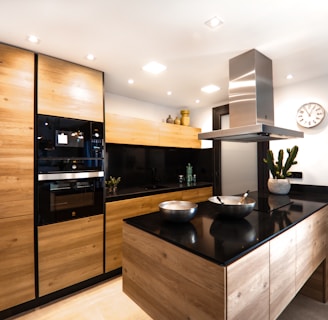The Culinary Canvas: Redefining Kitchen Spaces for Modern Living
Once hidden away like a family secret, the kitchen has experienced a remarkable reinvention. Today, this space commands center stage in our homes—no longer merely where meals materialize, but where life unfolds in its most authentic moments. This transformation reflects our collective shift toward more connected living experiences.
KITCHENINTERIORLIVING ROOMENVIRONMENTAL


Beyond the Countertop: The Kitchen's New Identity
The contemporary kitchen tells a story of liberation. Breaking free from the confines of back-of-house isolation, it now flows seamlessly into our living environments—a testament to changing priorities and lifestyle preferences. What began as a purely functional workspace has evolved into the magnetic core around which family rhythms revolve.
This architectural emancipation gained momentum during the late 20th century when designers began removing walls that had long segregated culinary spaces. The result? A revolutionary approach to home design that prioritizes togetherness over tradition. As barriers dissolved, so too did the separation between the act of preparation and the joy of connection.
The modern family's embrace of shared culinary experiences has further accelerated this evolution. From weekend baking projects to impromptu wine tastings, today's kitchen accommodates far more than meal creation—it hosts life's meaningful exchanges. Cultural phenomena like immersive cooking shows and the farm-to-table movement have transformed ordinary meal preparation into an art form worthy of center stage.
This space now balances dual identities with remarkable grace: a high-performance culinary workshop and an inviting social sanctuary where conversations flow as freely as the wine.


2025's Design Language: Form Following Feeling
This year's most compelling kitchen designs speak a distinctive language—one that communicates through both visual elegance and intuitive functionality. The defining characteristic? Spaces that adapt effortlessly to multiple purposes. Today's most desirable kitchens shift seamlessly from efficient meal preparation zones to sophisticated entertainment venues without missing a beat.
The architectural framework supporting this flexibility continues to favor openness and connectivity. Boundaries between traditional room designations have dissolved, creating fluid environments where cooking, dining, and living coexist harmoniously. The island has evolved from convenient workstation to social hub, often featuring tiered surfaces that delineate preparation zones from gathering areas through subtle elevation changes rather than hard divisions.
As urban living spaces continue their trend toward compression, storage innovation has become essential rather than optional. Today's most brilliant designs transform spatial limitations into opportunities for ingenuity—pull-out pantry systems that maximize narrow footprints, precision-engineered cabinetry that optimizes every vertical inch, and furnishings that serve multiple functions without visual compromise. The materials selected for these elements prioritize longevity and performance while maintaining impeccable aesthetic standards.
Perhaps most transformative is the invisible integration of technological advancement. The kitchen now responds intuitively to its occupants through sophisticated systems that anticipate needs and streamline routines. Voice-activated assistants coordinate appliance functions, smart refrigeration manages inventory with precision, and cooking systems can be orchestrated remotely—all without disrupting the space's visual serenity.
Consumer research confirms this direction, with homeowners consistently prioritizing designs that offer both technological sophistication and emotional resonance. As we move through 2025, the most successful kitchen environments will continue balancing innovation with intimacy—spaces that perform brilliantly while feeling inherently welcoming.


Treat yourself to
happiness today


Choreographing Culinary Spaces: The Architecture of Flow
The exceptional kitchen orchestrates movement with the precision of a ballet master. Behind its seamless functionality lies thoughtful spatial organization guided by time-tested principles. The work triangle—connecting refrigeration, cooking, and cleaning zones—remains the fundamental choreography that elevates culinary performance. This classical arrangement minimizes wasted movement while creating intuitive pathways that feel natural even to first-time visitors.
Progressive designers have expanded this concept through sophisticated zoning strategies. By establishing dedicated areas for specific functions—preparation, cooking, presentation, and cleanup—these kitchens accommodate multiple participants without creating conflict. This approach transforms meal creation from a solitary undertaking to a collaborative experience, perfect for both family engagement and gracious entertaining.
Spatial constraints demand particularly thoughtful solutions. In more compact environments, vertical thinking unlocks remarkable potential—wall systems that cascade upward rather than outward, floating elements that create visual lightness while providing substantial function, and multi-purpose components that adapt to changing needs throughout the day. Larger kitchens benefit from islands that serve as both architectural anchors and social magnets, creating natural gathering points without impeding workflow.
The truly exceptional kitchen achieves a state of effortless functionality—where movement feels intuitive and spaces perform their roles without announcing their purpose. This invisibility of function represents the highest achievement in kitchen design, creating environments that support rather than dictate the experience of their occupants.


The New Organization: Intelligent Storage as Design Philosophy
Today's most sophisticated kitchens treat storage as a design philosophy rather than an afterthought. Beyond mere containment, these systems reflect a deeper understanding of how we interact with our environments and the objects within them. Pull-out pantry configurations transform formerly awkward spaces into precision-organized inventory systems, making every item accessible without visual clutter.
The concept of concealment has evolved into an art form. Custom millwork now disguises professional-grade appliances behind façades that maintain design continuity. Specialized stations—coffee making, wine service, food preparation—can appear on demand and disappear completely when not needed. This approach creates visually serene environments that reveal their functionality layer by layer as required.
Vertical territory has been completely reimagined in contemporary design. Wall planes now support elegant organization systems that double as display opportunities—open shelving showcasing artisanal ceramics, suspended rack systems that make culinary tools accessible while creating visual interest, and modular components that adapt to evolving storage needs. These elements transform necessity into opportunity, elevating the practical to the aesthetic.
The thoughtful integration of these storage concepts defines excellence in today's kitchen environments—spaces where everything has its place, yet nothing feels rigidly contained. This balance between organization and flexibility creates culinary environments that support creative expression while maintaining visual harmony.


Luminous Environments: The Choreography of Light
Light orchestrates both mood and function in the contemporary kitchen, transforming the space throughout the day. The most exceptional environments feature sophisticated layering—task illumination providing precision where needed, ambient systems creating atmosphere, and accent elements highlighting architectural features or objects of beauty. This multilayered approach creates environments that respond to different activities and times of day with equal success.
The selection of lighting elements demands alignment with the kitchen's overall design narrative. Pendant fixtures suspended above islands or dining areas provide both focused illumination and sculptural interest. Recessed systems deliver clean architectural lines while ensuring comprehensive coverage. The artistry emerges through thoughtful composition—creating visual rhythm through strategic placement and intensity variation.
Today's luxury kitchens embrace advanced lighting technologies that enhance both performance and sustainability. LED systems deliver exceptional color rendering and energy efficiency, revealing food's true colors while minimizing consumption. Sophisticated control systems allow precise customization of intensity and temperature, adapting the environment to different activities without disrupting the space's visual harmony. As environmental consciousness continues influencing luxury design, these thoughtful illumination solutions will increasingly define exceptional culinary spaces.


Material Dialogue: The Conversation Between Color and Texture
The materials and colors selected for a kitchen create its emotional signature—the sensory experience that remains long after specific design details have faded from memory. In 2025, the most compelling spaces engage in sophisticated chromatic conversations. Deep blues and forest greens introduce tranquility and depth, while strategic moments of terracotta or amber provide warmth and energy. Neutral foundations in limestone whites and graphite grays continue offering timeless versatility—canvases that accommodate both bold expression and subtle refinement.
Environmental context profoundly influences these selections. Natural light patterns, architectural features, and spatial dimensions each demand specific consideration. Lighter palettes can visually expand intimate spaces, while deeper tones create atmosphere and intention in more generous environments. The most successful designs maintain color harmony that transitions naturally between kitchen and adjacent living areas, creating cohesive experiences throughout the home.
Material choices further articulate this sensory narrative. Premium surfaces like honed quartz offer sophisticated performance with exceptional durability, albeit at higher investment levels. Natural wood brings irreplaceable warmth and character through its organic variations and tactile qualities. Metals introduce precision and reflectivity—from the industrial strength of stainless to the warming patina of brushed brass.
Today's most distinctive kitchens orchestrate these elements in unexpected combinations—perhaps juxtaposing warm wood against cool stone, or introducing textural contrast between rough and polished surfaces. This intentional dialogue between materials creates environments with depth and authenticity—spaces that reveal new details with each interaction rather than surrendering all their secrets at first glance.


The Intelligent Kitchen: Technology's Seamless Integration
The evolution of smart home technology has fundamentally transformed luxury kitchen design, ushering in an era where innovation enhances every aspect of the culinary experience. Today's most advanced kitchens seamlessly incorporate intelligent systems that anticipate needs while simplifying complexity—the hallmark of truly sophisticated design.
Premium refrigeration systems now track inventory with precision, suggesting recipe possibilities based on available ingredients and helping minimize waste. Sophisticated ovens offer remote programming capabilities via elegant smartphone interfaces, allowing temperature adjustments or cooking time modifications from anywhere. This level of connectivity not only streamlines meal preparation but accommodates the fluid nature of contemporary living.
Kitchen automation extends beyond individual appliances to create holistic experiences. Voice-activated assistants orchestrate cooking sequences, manage timing, and curate atmospheric elements like lighting and music. Specialized innovations—from intelligent scales to app-controlled coffee systems—further elevate the culinary journey, making food preparation not merely efficient but genuinely pleasurable.
The art lies in integrating these technological marvels without compromising design integrity. Today's most admired kitchens achieve perfect balance—spaces where cutting-edge functionality exists within environments of exceptional beauty. This harmony between innovation and aesthetics defines the new standard in luxury kitchen design, creating spaces that enhance both the art and science of culinary creation.
